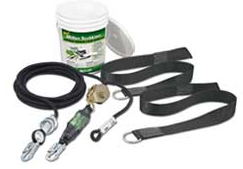
We live and work in an internet age where almost everything can be found online with the click of a mouse. We can search the internet for answers to the most vexing problems, and more importantly, we can buy just about anything, including fall protection systems. Although it may be tempting to buy a horizontal lifeline kit online, there are compelling reasons to think twice before placing a temporary HLL into your shopping cart.
At first glance, a temporary lifeline is a tempting offer. It is aggressively priced and once ordered, the kit arrives at your facility in just a few days. It is a DIY solution, meaning your maintenance staff can perform the installation, saving time and money. Where it is a cost-effective solution, is it the right solution for you and your company?
There may be situations where a temporary lifeline system might in fact be an appropriate play—think of a construction site—but the system must be installed properly by someone who understands how the system is designed to work. By way of example, the end anchors for the temporary lifeline must meet the OSHA standard of 5,000 lbs. How do you know if the anchor points truly meet this standard? Despite the claims of their manufacturers, temporary horizontal lifeline systems actually have greater deflection and require higher fall clearances in the event of a fall. Very seldom are temporary lifeline systems installed correctly, and all too often, we see temporary systems used as permanent systems. Maintenance simply sets the system up and walks away. It doesn’t take much to see what’s wrong with this scenario—the name says it all—these systems are TEMPORARY.
An Engineered fall protection system is a completely different animal than a temporary lifeline system. Systems designed by a qualified person have end anchors rated to withstand two times the applied load in the event of a fall. In this case, a fall protection engineer uses professional training and knowledge to determine the anchor points and connections are strong enough to arrest a fall and to reduce required fall distances. A permanently installed horizontal lifeline is made from stainless steel cable rather than a reinforced, synthetic nylon rope. Most importantly, the system is PERMANENT.
The savings that come with temporary horizontal lifelines may seem tempting, but there are very real potential dangers associated with their use, both when used as intended (e.g., a construction site) and as a permanent fall protection solution. When temporary systems are incorrectly installed or used in inappropriate ways, a fall can have devastating, or even catastrophic consequences. We are all interested in saving money and cutting costs in the work-place, but when the desire to trim budgets puts the lives of your contractors and employees at risk, something is wrong. The stakes are too high and the consequences may haunt you for a lifetime. Contact Diversified Fall Protection to learn more on how a permanent fall protection solution can change your outlook on safety. You’ll be glad you did.

